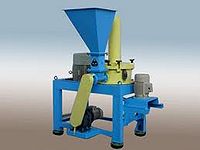Classifiers
There are many different types of classifiers which can be broadly grouped into two classes depending on the direction of flow of the carrying current.
Horizontal current classifiers such as mechanical classifiers are essentially of the free-settling type and accentuate the sizing function.
Vertical current or hydraulic classifiers are usually hindered-settling types and so increase the effect of density on the separation.
Types
These are free settling type classifiers and there are different varieties. Some are discussed below:
Settling cones
These are the simplest form of classifier, in which there is little attempt to do more than separate the solids from the liquid, i.e. they are sometimes used as dewatering units in small-scale operations. They are often used in the aggregate industry to de-slime coarse sands products.
Mechanical classifiers
Several forms of classifier exist in which the material of lower settling velocity is carried away in a liquid overflow, and the material of higher settling velocity is deposited on the bottom of the equipment and is dragged upwards against the flow of liquid by some mechanical means. The pulp feed is introduced into the inclined trough and forms a settling pool in which particles of high falling velocity quickly fall to the bottom of the trough. The settled sands are conveyed up the inclined trough by some mechanical means.
The rake classifier
It is a mechanical classifier utilising rakes. The rakes are actuated by an eccentric motion to dip into the settled material and move it up the incline for a short distance. The rakes are then withdrawn, and return to the starting-point, where the cycle is repeated; the settled material is thus slowly moved up the incline to the discharge. In the duplex type one set of rakes is moving up, while the other set returns.
Spiral classifiers
This classifier uses a continuously revolving spiral to move the sands up the slope. They can be operated at steeper slopes than the rake classifier, in which the sands tend to slip back when the rakes are removed. Steeper slopes aid the drainage of sands, giving a cleaner, drier product. Agitation in the pool is less than in the rake classifier which is important in separations of very fine material.
Video
